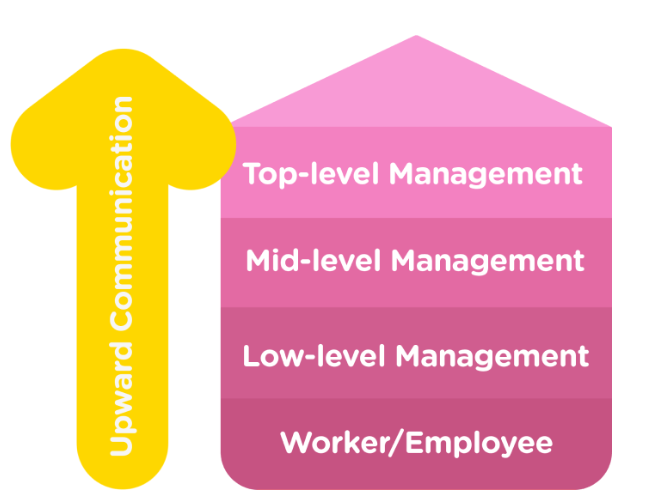Upward Communication: How to Create an Easy Flow of Information From Employees to Executives
For effective communication, employees and leadership must identify creative communication methods
by Jenna Bunnell - February 7th, 2023
US businesses lose up to $550 billion annually due to disengaged workers. Therefore, it’s crucial to keep them as informed and interested in corporate happenings as possible.

Source: Toner Buzz
For effective communication within a company, employees and top management must identify unique and creative communication methods, such as an enterprise communication system they can use for their business processes.
This article will shed more light on upward communication, clarify how it varies from downward communication, identify its benefits, and explore several effective ways of implementing upward communication within the workplace.
Download the 2023 HR Compliance Calendar
Is There a Difference Between Upward and Downward Communication?
Effective communication entails two distinct facets: upward communication and downward communication. However, just because they’re so different doesn’t mean they can’t complement one another. They deliver results and provide depth to workplace communications when utilized together.
What is Upward Communication?
The term “upward communication” refers to how workers convey their opinions and suggestions to the company’s upper management, whether they’re junior designers, HR administrators, or executive assistants.
This might take the shape of anything from radical new ideas to worries about processes or warnings about shifts in the marketplace. Or just general information that employees think the team as a whole may benefit from hearing.
For example, if your company is looking for someone knowledgeable in a specific open-source programming language to help improve your cloud-based services, ask the team! You may find that your employees know of experienced developers for hire or even have experienced themselves.
As a means through which employees can have their voices heard and ideas shared, upward communication plays a significant part in shaping the company’s culture. Employee engagement and satisfaction in a company increase when upward communication is implemented successfully and used to address the requirements of employees.

Source: Pumble
What is Downward Communication?
This consists of orders and memos from higher-ups. It often entails receiving directives, demands, and orders without being given a chance to respond, making it somewhat restrictive.
The goal of downward communication is to get the word from the boss down to the workers. This is a time-tested method of leadership and coordination. Direct communication from management to staff provides guidance on specific issues inside the organization.
Why is Upward Communication Important in the Workplace?
The disparity between a broadcast and a conversational approach to communication is the defining quality of upward communication. The best communication strategies include opportunities for employee input, idea exchange, addressing issues, and accommodating different information streams moving in multiple directions.
Some positive effects of internal upward communication in organizations include:
It Facilitates Deeper Connections
Upward communication can foster trust between management and lower-level employees. It allows regular workers to believe that higher-ups will take their ideas seriously. On the other hand, management can expect that when workers use this communication channel, they are more proactive and productive.
It Encourages Creativity and Efficiency
When workers know they are being heard, they are more willing to go the extra mile on the job. A study by Zenger Folkman found that 66% of employees with helpful and communicative leaders put in extra effort in their day-to-day work.
The input from customers, best practices, recommendations, and innovation can all be significantly improved by giving frontline staff a voice.
Organizational Balance
Upward communication is vital for organizational balance among employees. When there is high employee engagement in upward communications, they are more likely to inquire about and seek clarification about the company’s mission, values, and strategic priorities. When companies stick to one-way communication models, they miss the opportunity to address any concerns employees may have.
This causes confusion and a chasm between leadership’s expectations and what workers should be doing.
It Helps Managers Improve
Managers can become more effective leaders by communicating upward and receiving feedback on their performance. Managers, like their employees, might be getting things wrong without knowing it; criticism can provide insight into their leadership abilities and the areas they need to improve.
Effective Crisis and Change Management
Keeping employees happy in the face of ongoing changes in the workplace requires flexibility on the part of most businesses. Such sudden shifts in the status quo can be disastrous for companies that haven’t prepared for them with a crisis, continuity, or change management strategy.
Employees are the organization’s most valuable resource. Therefore, it’s crucial that management keep them in the loop about any changes that will affect them.
Managers need to hear from workers about how they’re feeling in challenging situations, which can only happen if they know they can communicate freely.
Improves Employee Satisfaction
When employees are encouraged to talk to their superiors, this upward communication increases their job satisfaction. By showing that they appreciate their employees’ opinions, management sends a strong message that they are listening to them and are willing to act on their recommendations.
What Are the Barriers to Effective Upward Communication?
While there are certainly benefits to communicating upward, there are also barriers that prevent this from happening. If these are faced head-on, they can be managed. But if you don’t do anything about it, they become a problem. Among them are:
FOSO
The “fear of speaking out” (FOSO) occurs when employees are intimidated or have no idea who they should be addressing and if they are even communicating via the appropriate channel. They can’t see or follow up on how their message is received and processed. As a result, they may be reluctant to speak up for fear of repercussions at work.
Autocratic Management
Oftentimes, FOSO is a result of autocratic leadership. When crises like employee layoffs emerge, autocratic managers may act in a more authoritarian manner, ignore the opinions of lower-level employees, and even penalize those who try to speak up.
This kind of manager typically has a hierarchical worldview that devalues subordinates. They smother any efforts by lower-level employees to participate in decision-making or provide suggestions, reducing their motivation and output.
No Follow-Up
What happens after employees provide feedback? What could be more disheartening than making a comment, sharing an opinion, or making a proposal, only to have nothing come of it? Employees will lose interest in providing feedback if they see that it is not respected and never see the outcomes of their suggestions being implemented.
Management Resistance
This occurs when management is unwilling to comply with the upward communication plan. Another issue is being unprepared to deal with certain situations, such as being met with resistance or receiving criticism.
Even helpful criticism can sometimes hurt someone’s feelings. However, when those in authority are resistive, it can convey the impression that such upward communication is not welcome.
No Dedicated Communication Channel
Employees who wish to make their voices heard need to be given the means to do so. They need a dedicated channel to provide useful feedback to the appropriate individual. This assures them that their opinions will be heard.
How to Implement Upward Communication in the Workplace
Here are a few examples of implementing upward communication in the workplace:
Employee Feedback Reports
With the use of performance reports, lower-level workers can provide feedback on the work of their superiors and other corporate authorities as part of upward communication. Managers can use these reports to learn how to lead their teams better and make the necessary adjustments to their own behavior, skill sets, and management approach.
The performance reports can be delivered simultaneously with employee performance assessments to show that corporate authorities are just as aware of the need to improve as their employees.
Employee Satisfaction Surveys
Employee satisfaction surveys can be used to get a feel for how satisfied workers are with their jobs, the company’s culture, and the opportunities they have within it. A survey is an effective approach to upward communication that asks workers to assess various aspects of their work experience.
In addition, an employee experience platform can help track the entire lifecycle of an employee so leaders can gain valuable insights into employee experiences, satisfaction, and engagement.
Employee Suggestion Boxes
Perhaps a touch dated, but it gets the job done. It could be a physical suggestion box, where workers physically drop off written suggestions, complaints, or recommendations for management to read, or an electronic format using an anonymous workflow.
Organizational leaders can set up a dedicated email address for workers to voice their opinions, concerns, and recommendations. Adding some structure, such as having workers submit ideas and then vote on the ones they like most, may make the process even more productive.
Group Meetings
Meetings between management and workers are an example of upward communication since they facilitate interaction between all levels of the organization. It may be a one-on-one chat with a supervisor or a company-wide gathering where everyone from entry-level workers to the CEO shares recent accomplishments or discusses some pressing business matter.
Focus Groups
Most focus groups include an HR specialist or a corporate representative present to facilitate the discussion. Regular departmental problems can be discussed in focus groups, or employees can be polled on how they feel about a proposed policy change.
These meetings are recorded so that other high-ranking officials can review them and use the information to inform their own decisions. Of course, you can also do this online, provided you use the correct cloud collaboration services to ensure that all participants feel comfortable voicing their opinions.
Improve Collaboration with Upward Communication
With the information presented above, it’s clear that upward communication is crucial for productivity, engagement, and avoiding miscommunication in the workplace. Employees and management must collaborate to strengthen bottom-up communication inside the company.
Furthermore, a company’s external reputation might benefit from effective two-way internal communication. Remember that motivated workers are the best representatives of any company. Employees will speak poorly about a corporation that does not care about them. They won’t give their all to their tasks, which will have far-reaching consequences for the business.
So take the advice from this post and let your employees share their opinions. You are sure to see the benefits!
Recommended Posts
22 Employee Engagement Ideas That Remote Workers Love
Blog Articles
35+ Employee Engagement Survey Questions You Must Ask
Blog Articles
Search...
Product
GoCo
Resources
Articles
eBooks
Webinars
Customer Stories


